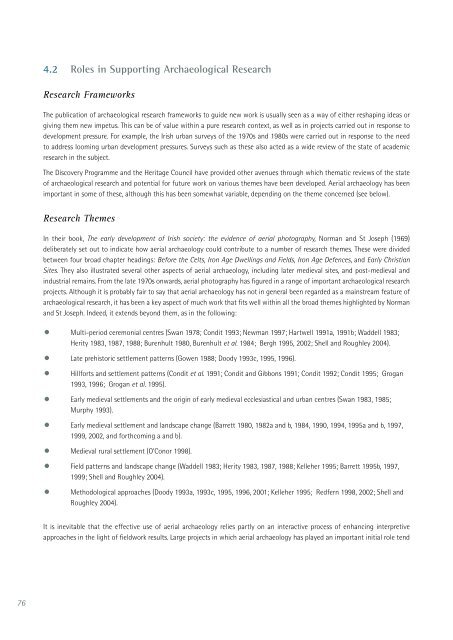Aerial Archaeology in Ireland - The Heritage Council
Aerial Archaeology in Ireland - The Heritage Council
Aerial Archaeology in Ireland - The Heritage Council
Create successful ePaper yourself
Turn your PDF publications into a flip-book with our unique Google optimized e-Paper software.
76<br />
4.2 Roles <strong>in</strong> Support<strong>in</strong>g Archaeological Research<br />
Research Frameworks<br />
<strong>The</strong> publication of archaeological research frameworks to guide new work is usually seen as a way of either reshap<strong>in</strong>g ideas or<br />
giv<strong>in</strong>g them new impetus. This can be of value with<strong>in</strong> a pure research context, as well as <strong>in</strong> projects carried out <strong>in</strong> response to<br />
development pressure. For example, the Irish urban surveys of the 1970s and 1980s were carried out <strong>in</strong> response to the need<br />
to address loom<strong>in</strong>g urban development pressures. Surveys such as these also acted as a wide review of the state of academic<br />
research <strong>in</strong> the subject.<br />
<strong>The</strong> Discovery Programme and the <strong>Heritage</strong> <strong>Council</strong> have provided other avenues through which thematic reviews of the state<br />
of archaeological research and potential for future work on various themes have been developed. <strong>Aerial</strong> archaeology has been<br />
important <strong>in</strong> some of these, although this has been somewhat variable, depend<strong>in</strong>g on the theme concerned (see below).<br />
Research <strong>The</strong>mes<br />
In their book, <strong>The</strong> early development of Irish society: the evidence of aerial photography, Norman and St Joseph (1969)<br />
deliberately set out to <strong>in</strong>dicate how aerial archaeology could contribute to a number of research themes. <strong>The</strong>se were divided<br />
between four broad chapter head<strong>in</strong>gs: Before the Celts, Iron Age Dwell<strong>in</strong>gs and Fields, Iron Age Defences, and Early Christian<br />
Sites. <strong>The</strong>y also illustrated several other aspects of aerial archaeology, <strong>in</strong>clud<strong>in</strong>g later medieval sites, and post-medieval and<br />
<strong>in</strong>dustrial rema<strong>in</strong>s. From the late 1970s onwards, aerial photography has figured <strong>in</strong> a range of important archaeological research<br />
projects. Although it is probably fair to say that aerial archaeology has not <strong>in</strong> general been regarded as a ma<strong>in</strong>stream feature of<br />
archaeological research, it has been a key aspect of much work that fits well with<strong>in</strong> all the broad themes highlighted by Norman<br />
and St Joseph. Indeed, it extends beyond them, as <strong>in</strong> the follow<strong>in</strong>g:<br />
• Multi-period ceremonial centres (Swan 1978; Condit 1993; Newman 1997; Hartwell 1991a, 1991b; Waddell 1983;<br />
Herity 1983, 1987, 1988; Burenhult 1980, Burenhult et al. 1984; Bergh 1995, 2002; Shell and Roughley 2004).<br />
•<br />
Late prehistoric settlement patterns (Gowen 1988; Doody 1993c, 1995, 1996).<br />
• Hillforts and settlement patterns (Condit et al. 1991; Condit and Gibbons 1991; Condit 1992; Condit 1995; Grogan<br />
1993, 1996; Grogan et al. 1995).<br />
• Early medieval settlements and the orig<strong>in</strong> of early medieval ecclesiastical and urban centres (Swan 1983, 1985;<br />
Murphy 1993).<br />
• Early medieval settlement and landscape change (Barrett 1980, 1982a and b, 1984, 1990, 1994, 1995a and b, 1997,<br />
1999, 2002, and forthcom<strong>in</strong>g a and b).<br />
•<br />
Medieval rural settlement (O’Conor 1998).<br />
• Field patterns and landscape change (Waddell 1983; Herity 1983, 1987, 1988; Kelleher 1995; Barrett 1995b, 1997,<br />
1999; Shell and Roughley 2004).<br />
• Methodological approaches (Doody 1993a, 1993c, 1995, 1996, 2001; Kelleher 1995; Redfern 1998, 2002; Shell and<br />
Roughley 2004).<br />
It is <strong>in</strong>evitable that the effective use of aerial archaeology relies partly on an <strong>in</strong>teractive process of enhanc<strong>in</strong>g <strong>in</strong>terpretive<br />
approaches <strong>in</strong> the light of fieldwork results. Large projects <strong>in</strong> which aerial archaeology has played an important <strong>in</strong>itial role tend

















